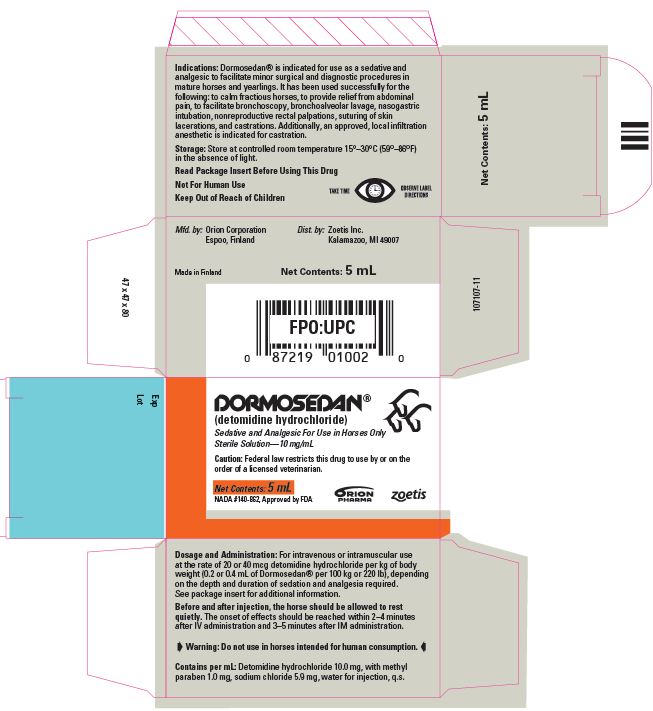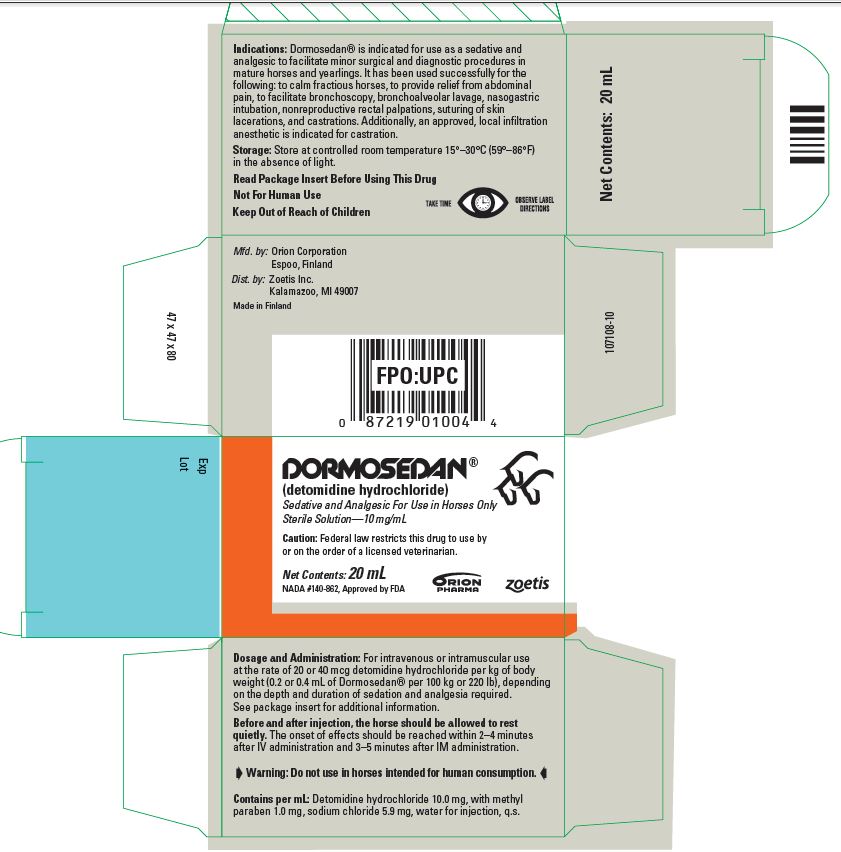DORMOSEDAN STERILE- detomidine hydrochloride solution
Dormosedan by
Drug Labeling and Warnings
Dormosedan by is a Animal medication manufactured, distributed, or labeled by Zoetis Inc.. Drug facts, warnings, and ingredients follow.
Drug Details [pdf]
- SPL UNCLASSIFIED SECTION
- CAUTION
-
DESCRIPTION
Dormosedan® is a synthetic alpha-2 adrenoreceptor agonist with sedative and analgesic properties. The chemical name is 1H imidazole, 4-[(2,3-dimethylphenyl) methyl]- hydrochloride and the generic name is detomidine hydrochloride. It is a white, crystalline, water-soluble substance having a molecular weight of 222.7. The molecular formula is C12H14N2∙HCl.
CHEMICAL STRUCTURE:

Each mL of Dormosedan® contains 10.0 mg detomidine hydrochloride, 1.0 mg methyl paraben, 5.9 mg sodium chloride, and water for injection, q.s.
-
CLINICAL PHARMACOLOGY
Dormosedan®, a non-narcotic sedative and analgesic, is a potent α2-adrenoreceptor agonist which produces sedation and superficial and visceral analgesia which is dose dependent in its depth and duration. Profound lethargy and a characteristic lowering of the head with reduced sensitivity to environmental stimuli (sounds, etc.) are seen with detomidine. A short period of incoordination is characteristically followed by immobility and a firm stance with front legs well spread. The analgesic effect is most readily seen as an increase in the pain threshold at the body surface. Sensitivity to touch is little affected and in some cases may actually be enhanced.
With detomidine administration, heart rate is markedly decreased, blood pressure is initially elevated, and then a steady decline to normal is seen. A transient change in the conductivity of the cardiac muscle may occur, as evidenced by partial atrioventricular (AV) and sinoauricular (SA) blocks. This change in the conductivity of the cardiac muscle may be prevented by IV administration of atropine at 0.02 mg/kg of body weight.
No effect on blood clotting time or other hematological parameters was encountered at dosages of 20 or 40 mcg/kg of body weight. Respiratory responses include an initial slowing of respiration within a few seconds to 1–2 minutes after administration, increasing to normal within 5 minutes. An initial decrease in tidal volume is followed by an increase.
-
INDICATIONS
Dormosedan® is indicated for use as a sedative and analgesic to facilitate minor surgical and diagnostic procedures in mature horses and yearlings. It has been used successfully for the following: to calm fractious horses, to provide relief from abdominal pain, to facilitate bronchoscopy, bronchoalveolar lavage, nasogastric intubation, nonreproductive rectal palpations, suturing of skin lacerations, and castrations. Additionally, an approved, local infiltration anesthetic is indicated for castration.
-
CONTRAINDICATIONS
Dormosedan® should not be used in horses with pre-existing AV or SA block, with severe coronary insufficiency, cerebrovascular disease, respiratory disease, or chronic renal failure. Intravenous potentiated sulfonamides should not be used in anesthetized or sedated horses as potentially fatal dysrhythmias may occur.
Information on the possible effects of detomidine hydrochloride in breeding horses is limited to uncontrolled clinical reports; therefore, this drug is not recommended for use in breeding animals.
- WARNINGS
-
HUMAN SAFETY INFORMATION
Care should be taken to assure that detomidine hydrochloride is not inadvertently ingested as safety studies have indicated that the drug is well absorbed when administered orally. Standard ocular irritation tests in rabbits using the proposed market formulation have shown detomidine hydrochloride to be nonirritating to eyes. Primary dermal irritation tests in guinea pigs using up to 5 times the proposed market concentration of detomidine hydrochloride on intact and abraded skin have demonstrated that the drug is nonirritating to skin and is apparently poorly absorbed dermally. However, in accordance with prudent clinical procedures, exposure of eyes or skin should be avoided and affected areas should be washed immediately if exposure does occur. As with all injectable drugs causing profound physiological effects, routine precautions should be employed by practitioners when handling and using loaded syringes to prevent accidental self-injection.
-
PRECAUTIONS
Before administration, careful consideration should be given to administering Dormosedan® to horses approaching or in endotoxic or traumatic shock, to horses with advanced liver or kidney disease, or to horses under stress from extreme heat, cold, fatigue, or high altitude. Protect treated horses from temperature extremes. Some horses, although apparently deeply sedated, may still respond to external stimuli. Routine safety measures should be employed to protect practitioners and handlers. Allowing the horse to stand quietly for 5 minutes before administration and for 10–15 minutes after injection may improve the response to Dormosedan®.
Dormosedan® is a potent α2-agonist, and extreme caution should be exercised in its use with other sedative or analgesic drugs for they may produce additive effects.
When using any analgesic to help alleviate abdominal pain, a complete physical examination and diagnostic work-up are necessary to determine the etiology of the pain.
Food and water should be withheld until the sedative effect of Dormosedan® has worn off.
-
ADVERSE REACTIONS
Occasional reports of anaphylactic-like reactions have been received, including 1 or more ofthe following: urticaria, skin plaques, dyspnea, edema of the upper airways, trembling, recumbency, and death. The use of epinephrine should be avoided since epinephrine may potentiate the effects of α2-agonists. Reports of mild adverse reactions have resolved uneventfully without treatment. Severe adverse reactions should be treated symptomatically. As with all α2-agonists, the potential for isolated cases of hypersensitivity exist, including paradoxical response (excitation).
-
SIDE EFFECTS
Horses treated with Dormosedan® exhibit hypertension. Bradycardia routinely occurs 1 minute after injection. The relationship between hypertension and bradycardia is consistent with an adaptive baroreceptor response to the increased pressure and inconsistent with a primary drug-induced bradycardia. Piloerection, sweating, salivation, and slight muscle tremors are frequently seen after administration. Partial transient penis prolapse may be seen. Partial AV and SA blocks may occur with decreased heart and respiratory rates. Urination typically occurs during recovery at about 45–60 minutes posttreatment, depending on dosage. Incoordination or staggering is usually seen only during the first 3–5 minutes after injection, until animals have secured a firm footing.
Because of continued lowering of the head during sedation, mucus discharges from the nose and, occasionally, edema of the head and face may be seen. Holding the head in a slightly elevated position generally prevents these effects.
-
OVERDOSAGE
Detomidine hydrochloride is tolerated in horses at up to 200 mcg/kg of body weight (10 times the low dosage and 5 times the high dosage). In safety studies in horses, detomidine hydrochloride at 400 mcg/kg of body weight administered daily for 3 consecutive days produced microscopic foci of myocardial necrosis in 1 of 8 horses.
-
DOSAGE AND ADMINISTRATION:
For Sedation
Administer Dormosedan® IV or IM at the rates of 20 or 40 mcg detomidine hydrochloride per kg of body weight (0.2 or 0.4 mL of Dormosedan® per 100 kg or 220 lb), depending on the depth and duration of sedation required. Onset of sedative effects should be reached within 2–4 minutes after IV administration and 3–5 minutes after IM administration. Twenty mcg/kg will provide 30–90 minutes of sedation and 40 mcg/kg will provide approximately 90 minutes to 2 hours of sedation.
For Analgesia
Administer Dormosedan® IV at the rates of 20 or 40 mcg detomidine hydrochloride per kg of body weight (0.2 or 0.4 mL of Dormosedan® per 100 kg or 220 lb), depending on the depth and duration of analgesia required. Twenty mcg/kg will usually begin to take effect in 2–4 minutes and provide 30–45 minutes of analgesia. The 40 mcg/kg dose will also begin to take effect in 2–4 minutes and provide 45–75 minutes of analgesia.
For Both Sedation and Analgesia
Administer Dormosedan® IV at the rates of 20 or 40 mcg detomidine hydrochloride per kg of body weight (0.2 or 0.4 mL of Dormosedan® per 100 kg or 220 lb), depending on the depth and duration of sedation and analgesia required.
Before and after injection, the animal should be allowed to rest quietly.
- STORAGE
- HOW SUPPLIED
- SPL UNCLASSIFIED SECTION
- PRINCIPAL DISPLAY PANEL - 5 mL Vial Carton
- PRINCIPAL DISPLAY PANEL - 20 mL Vial Carton
-
INGREDIENTS AND APPEARANCE
DORMOSEDAN STERILE
detomidine hydrochloride solutionProduct Information Product Type PRESCRIPTION ANIMAL DRUG Item Code (Source) NDC: 54771-6290 Route of Administration INTRAMUSCULAR, INTRAVENOUS Active Ingredient/Active Moiety Ingredient Name Basis of Strength Strength DETOMIDINE HYDROCHLORIDE (UNII: 95K4LKB6QE) (DETOMIDINE - UNII:7N8K34P2XH) DETOMIDINE 10 mg in 1 mL Inactive Ingredients Ingredient Name Strength METHYLPARABEN (UNII: A2I8C7HI9T) 1 mg in 1 mL SODIUM CHLORIDE (UNII: 451W47IQ8X) 5.9 mg in 1 mL WATER (UNII: 059QF0KO0R) Packaging # Item Code Package Description Marketing Start Date Marketing End Date 1 NDC: 54771-6290-1 1 in 1 CARTON 1 5 mL in 1 VIAL, MULTI-DOSE 2 NDC: 54771-6290-2 1 in 1 CARTON 2 20 mL in 1 VIAL, MULTI-DOSE Marketing Information Marketing Category Application Number or Monograph Citation Marketing Start Date Marketing End Date NADA NADA140862 12/06/1989 Labeler - Zoetis Inc. (828851555)
Trademark Results [Dormosedan]
Mark Image Registration | Serial | Company Trademark Application Date |
|---|---|
 DORMOSEDAN 73577830 1480396 Live/Registered |
FARMOS-YHTYMA OY (FARMOS GROUP LTD.) 1986-01-15 |
© 2025 FDA.report
This site is not affiliated with or endorsed by the FDA.

